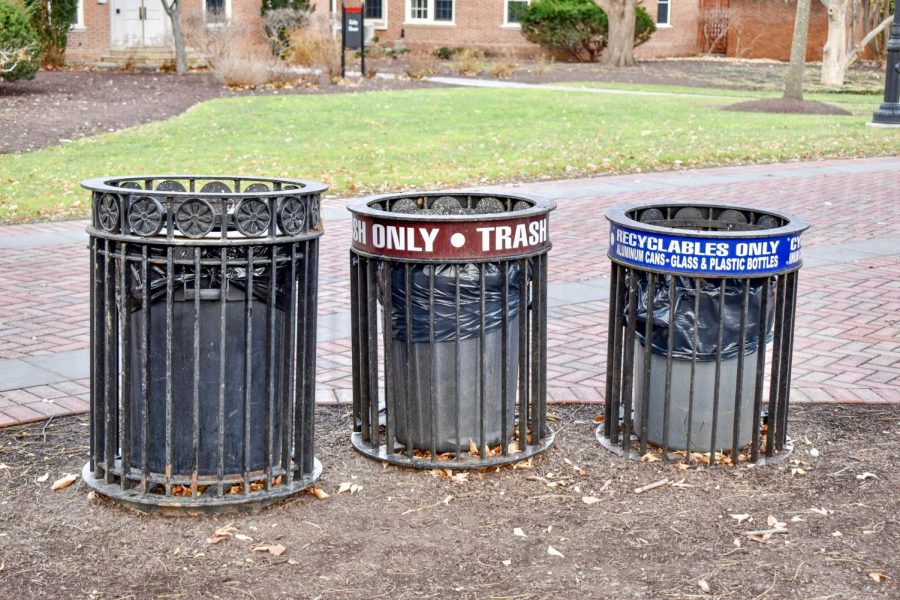A look into Lafayette’s recycling process
Waste bins such as these can be found around campus, where students can separate their trash between municipal waste and single-stream recycling. (Photo by Emma Sylvester ’25)
December 10, 2021
Lafayette students are subjected to many rumors in four years at the college: there are ghosts in Pardee attic, secret tunnels stretch the length of the quad and the college does not recycle.
Delicia Nahman, the college’s sustainability director put these rumors to rest. Lafayette does recycle but at a low rate.
“We recycle most paper, plastics one through seven, most common metals meaning aluminum cans and aluminum foil, glass jars and bottles that are for food and drink, and cardboard,” Nahman said “All of those items have to be emptied and cleaned in order for them to be accepted by are in order for them to be properly recycled.”
The catch is that for Lafayette to recycle the bag, there cannot be contaminants such as a dirty smoothie cup, standard municipal waste or even a full cup of water.
“If the custodial staff looks into a recycle bag, like a bag that is in a recycling bin and sees that there is contamination it goes into the trash,” Nahman explained. “They will not stick their hand in a bag and re-sort what a student should have sorted or ordered remove a contaminated item.”
The measure of this contamination, known as the contamination rate, represents the level of dirty or municipal waste items that can be in the recycling bin before the janitor has to move it to the trash.
“It’s usually the vendor that says ‘if you send me your dumpster of recycling, and we sort it and there’s more than a ten percent contamination rate, which then costs me, the vendor, more money to then re-sort, so we are rejecting all of it. And it is all going into it is all going to the landfill,” Nahman explained.
For Lafayette, if the contamination rate falls above 10%, the bin will be thrown in the trash. This number set externally by the vendor, and Lafayette custodians reinforce it internally.
“It’s a bit discretionary in that if two custodians look in the same bag will one see it as nine percent and one see it as eleven percent, but usually what ends up happening is that it’s pretty clear when it is contaminated because any drink, any smoothie cup if that is dirty at all, or it has any liquid in it and it gets thrown into the recycling bin, it then gets everything wet, and most things dirty,” Nahman said. “One item can actually contaminate the whole bag, even if it’s only one out of let’s say one hundred items that are in there.”
As a result, although there is a recycling program in place, there are high levels of contamination that result in lower annual tonnage of recycled items than what students are placing in blue bins.
Rumors that institutions do not recycle are a common perception Nahman has noticed at other schools such as Lehigh University.
“I think what most observers don’t quite have context for is if they were to see a custodian, take a recycling bag and put it in the trash that it is ninety-five percent of the time because the recycling is contaminated not because we don’t believe in it, it doesn’t matter to us, we don’t know how to do it, et cetera,” Nahman said.
She added that custodians are very well trained in this practice.
“I think that [the custodians] actually care quite a bit about various environmental topics including recycling. And so I think that they’re trying to do their best to support it while also not wanting to cause entire recycling loads to get rejected because there’s too much contamination,” Nahman said.
With single-stream recycling, all recycled items are thrown into the same bin. In 2020, we recycled 32.85 tons of waste, according to Nahman. In order to increase this number, students to properly dispose of waste.
“I think we need to recognize as an institution that what can be recycled looks very, very different depending on where you live, and I think that there is an opportunity for the campus to educate students about what it looks like here on campus…not just what items can go in there, but what the state of the item has to be, meaning clean and empty,” Nahman said. “I think also them knowing where to look if they do have questions. So what resources are available to them if they have questions, I think is also important.”
As a community, Lafayette has the opportunity to improve recycling, infrastructure, signage and education, but the core recycling program depends on proper recycling and sorting from students, Nahman said.
“That requires all of us to be aware of the fact that our items that can be recycled need to be clean and emptied before they are put into the recycling bin and that our office would love to work with any students that have ideas for how to improve our waste diversion efforts on campus so that we can reach sixty percent diversion rate by 2035,” Nahman said.
More information on how to properly recycle can be found at www.sustainability.lafayette.edu/recycling.






















































































































